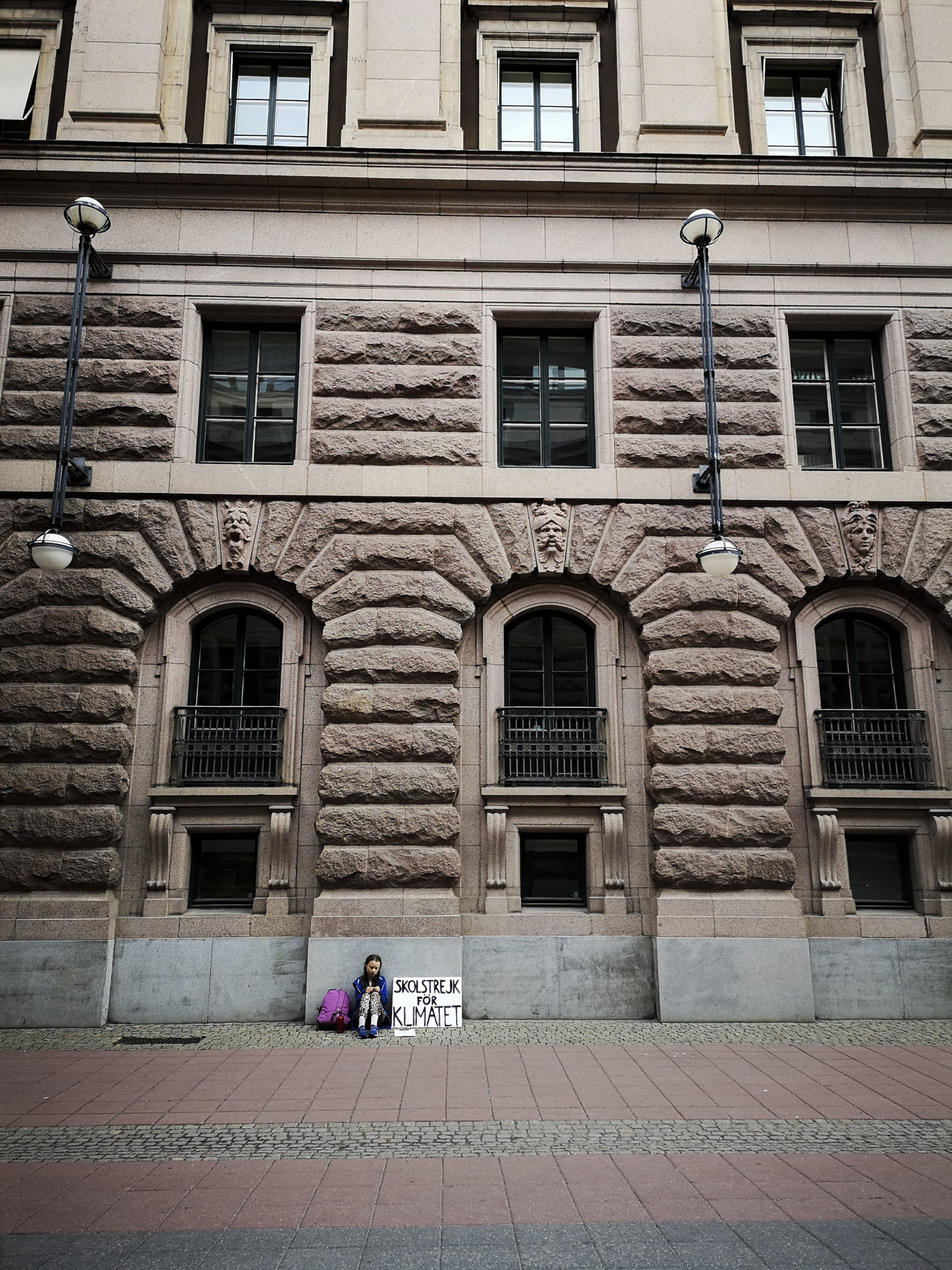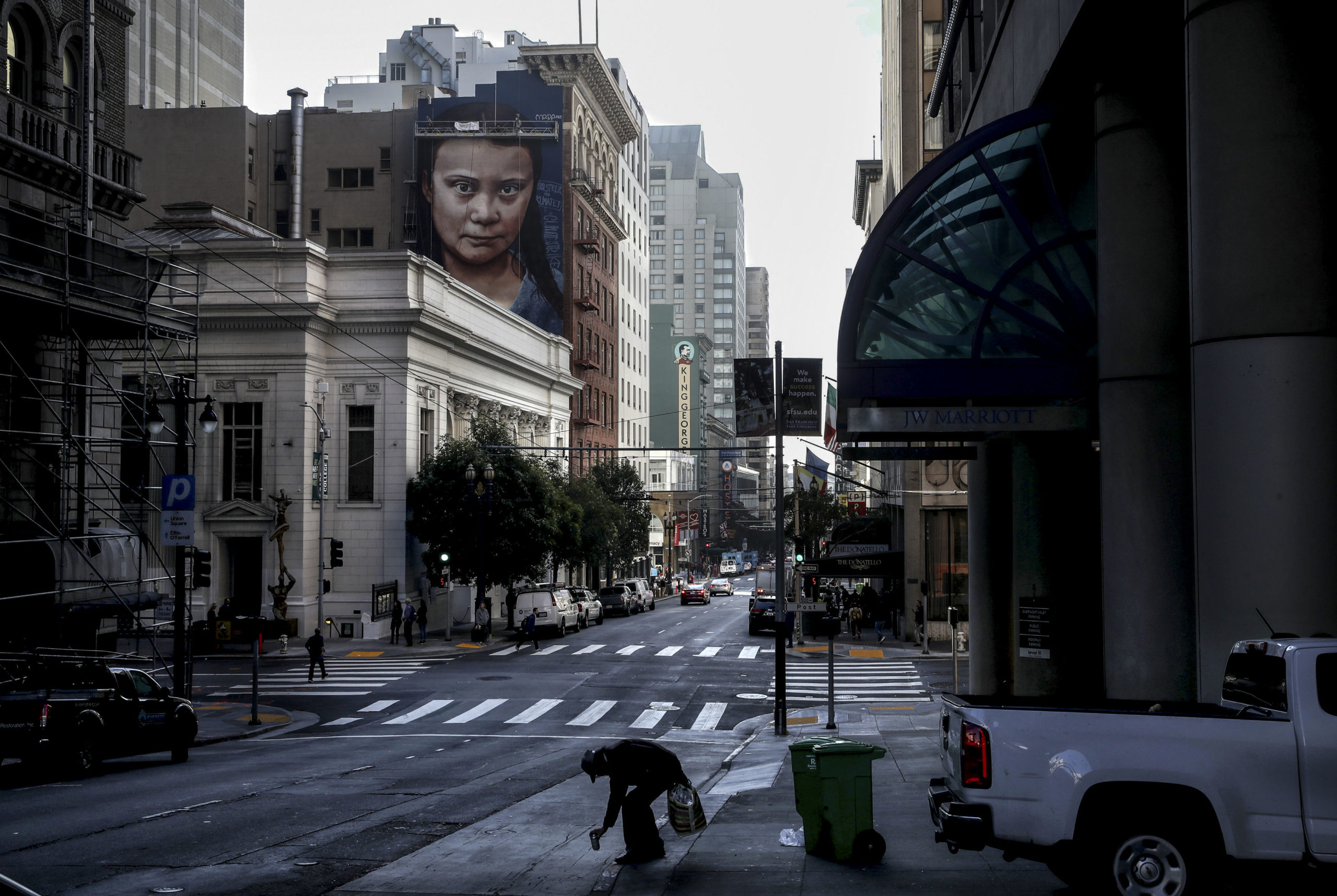Greta Thunberg addresses a crowd at the Global Climate Strike against the use of fossil fuels
COMMENT
Some are fascinated with Greta Thunberg: they see her as a young hero, a Joan of Arc or a Mafalda (Argentina’s comic strip girl who challenged the problems of the world) of modern times with a political agenda for Earth. Others are angry. They see her as a naïve puppet of opaque adult interests and they make fun of her.
The 16-year-old has become a new global figure representing the younger generation and their concerns for their future in the face of the climate crisis.
What is now a mass movement began on August 20 2018. That day, instead of attending school, Greta sat in front of the Swedish Parliament with a board that stated: “School Strike for Climate”. Her intervention built momentum and produced an avalanche called Fridays for Future.
In March 2019 about 1.5-million teenagers and youngsters took to the streets to demand governments take climate change seriously. Other strikes followed and in September an estimated four million young people and adults took to the streets in almost every country.

In the beginning: In August last year Greta Thunberg, didn’t go to school. She sat outside Sweden’s Parliament with a poster that read ‘School strike for climate’. Her protest has become a movement. (Adam Johansson)
Greta has been recognised for the firmness of her convictions and for her actions in Europe for about a year, but in the United States she attracted attention only in the latter half of 2019. Many Americans first saw her when she appeared on Trevor Noah’s The Daily Show. She explained with her well-known seriousness that the world has little time left — eight and a half years, because as of January 1 2018, only 420 gigatons of carbon dioxide remained to be emitted by all of humanity if climate change is to be kept to relatively safe levels. Now, there are only 360 gigatons left. That budget will vanish in less than eight years.
When asked for her impression of New York when she arrived on a zero-carbon emissions yacht from Europe, she replied that it smelled bad. Her lack of understanding of irony and her seriousness are probably related to a syndrome she has — Asperger’s, a condition she speaks openly about — and a dose of Nordic frankness.
Like her, the new environmental movement speaks very seriously and uses scientific research to support its arguments. Greta is the global face of this movement and her presence is influential. Her yacht trip from Europe in August attracted support, mockery and criticism.
Her interventions at the World Climate Conference in Katowice, Poland, in December 2018 and at the World Economic Forum in Davos, Switzerland, in September 2019 put the world’s powerful in an awkward position. This teenager with braids threw a challenge at them — “act” or “panic” — and attracted the world’s attention.
She told the US Congress: “I don’t want you to listen to me, I want you to listen to the scientists.”
Her presence at the New York and Washington demonstrations in September, the meeting with Barack Obama, her appearance on The Daily Show and the speech before the United Nations general assembly raised her profile in the US.

The teenage climate activist’s profile was raised in the US by appearing on The Daily Show with Trevor Noah (above) and a four-storey mural (below) in San Francisco. (Justin Sullivan/Getty Images)

Although in many countries the movement is led by teenage women, in no other country is the link between the movement and a person as clear as it is in the case of Greta. The media and commentators have become obsessed with her. Some observers say the adoration of Greta is similar to a religious awakening.
Those on the right and the climate deniers in particular regard Greta and her colleagues as immature, spoilt young people. Argentine journalist Sandra Russo calls this the first case of “global bullying”, an idea she discussed long before September 23, when US President Donald Trump sent out a tweet making fun of Greta after her speech at the UN Climate Action Summit.
“[S]he seems like a very happy young girl looking forward to a bright and wonderful future. So nice to see!” His tweet reflects his views of women and that he is a climate denialist.
Greta’s ideas about climate change have been described as potentially “undemocratic” — because they do not allow for political compromise — based on the idea that politics works only step by step, always through compromise. But this can be seen as a form of soft paternalism.
Andrew Mitrovica, writing for Al Jazeera, noted that Christopher Caldwell, a senior journalist for The Weekly Standard, wrote in The New York Times that Greta’s “appeals for immediate action” on the climate crisis are “in conflict with democracy” and took issue with her “crude language”, “unrealistic” world view, and “out of balance” priorities and that she “is only interested in ‘sowing panic’ and ‘simplification’.” Caldwell advised: “Democracy calls for waiting and seeing.”
Greta’s sharp accusations do not take place in a vacuum. They are stark, political interventions aimed at polarising public opinion. Her statement that “the poverty of the many pays for the luxury of the few” is, according to some commentators on the extreme right, “the product of socialisation in the Swedish education system” and is a “stupid” left-wing criticism of capitalism.
Other critics argue that “fanatical ecologists” (or green capitalists) are hiding behind the Swedish teenager. They make specific mention of We Don’t Have Time AB, a Swedish company that works on environmental projects. It was founded in 2017 by public relations specialist Ingmar Rentzhog, who gave wide coverage to the school strikes in 2018.
On November 27 2018, the company announced it was issuing securities on the stock exchange and mentioned her name 11 times in its advertising brochure. Earlier this year, she and her family said they are no longer in contact with the company.
Others point to financier and philanthropist George Soros and conspiracy theorists claim that Greta is his granddaughter. She is not. Neither is she a member of the Islamic State, as social media would have it.
What has happened with Greta in the last two years seems to suggest that the more popular and disruptive the climate movement becomes, the more virulent the rejection from those who consider climate change a conspiracy. The severity of reactions to a 16-year-old should make us reflect. Some psychologists try to explain it by saying “old white men” won’t change their attitudes towards the environment and so attack Greta for her Asperger’s, her age and because of the apparent manipulation of her activism.
But behind these criticisms there is much more than the intransigence of a whole male generation. The attacks may be a sign that she and other young people in the movement have hit a sensitive nerve: Is Greta questioning the system?
At the climate conference in Katowice, Greta said political elites had not yet understood the severity of the climate crisis. She added that, since the political class acts irresponsibly, it is up to the younger generations to take charge of their future and do what adult politics should have done a long time ago. Young people must understand what previous generations have done with climate change and respond to the chaos they have inherited. They need to ensure that their voices are heard.
In all of her speeches, Greta makes it clear that if real and concrete measures are not taken to face the current situation, politicians will be acting irresponsibly. She maintains that rich nations have a greater obligation to reduce emissions quicker and that countries such as Sweden should reduce their fossil fuel emissions by 15% annually and reduce their emissions to zero within six to 12 years. This would allow emerging economies such as India and Nigeria sufficient time to adapt their infrastructure.
The main concern of the Fridays for Future movement is, therefore, that climate protection measures be adapted in the widest, fastest and most efficient way possible to achieve the objective of limiting temperature rise to 1.5°C — a limit established at the Conference on Climate Change that was held in Paris in 2015 (COP 21) and adopted by the UN.
These positions of the Fridays for Future movement do not seem to question the system itself; they are simply a call to reason and for fulfilment of objectives that have already been established.
The power of persuasion of the movement comes from simply stating “what is happening”. It comes from insisting on the fact that, as the reports by the Intergovernmental Panel on Climate Change say, the climate crisis has worsened in the last 20 years and, despite this, politics is doing very little to change its course.
German climate movement activist Luisa Neubauer, 23, says that “the battlefield is between those who benefit most from the status quo and those who are set to lose the most”. She adds: “We young people ask ourselves why things are the way they are when they could so simply be different. And we have to fight this as strongly as we can because we have absolutely nothing to lose, except our future.”
There is potential for generational conflict: voters of the future are mobilising against the interests of those of the present. But young people are not alone; many adults support the movement. This was demonstrated by the large number who participated in the climate strike marches on September 20 and 27.

Shake-up: Millions of people around the world took to the streets in September as part of the Global Climate Strike against the use of fossil fuels, including in Brussels. (Kenzo Tribouillard/ AFP)
Greta has created mass mobilisation through her statements, actions in the public eye and intervention in the media. The movement’s objective is not and cannot be to solve the climate crisis, but it has won a more immediate political success: a generalised and global awareness of the urgency of climate change. What Greta says and does already influences political debates in various countries and first steps, although still tentative, are being taken to act on climate change. Without mobilisation, this would not be happening.
The European Green Party, which is active across the continent, is one of the main beneficiaries of advertising the strikes and protests of the climate movement. In Germany, for example, the Greens obtained 20.5% of the votes in the 2019 European elections, with 33% of the votes being that of people under the age of 30. The electoral behaviour of young people is not just an expression of their sympathy for the environmental cause; it is also a reflection of the deep crisis that German social democracy is going through.

Greta Thunberg was named person of the year by TIME. (Evgenia Arbugaeva)
The new climate movement has created a new political actor. They will need a lot of patience to continue the campaign. The fascination with the novelty that is Greta and her personal magnetism will diminish, as will the wave of sympathy. Traditional media and social media do not stick to the same story for long. Greta will return to school. Her generation has a lifetime ahead, but this movement should become an example of democratic commitment.
Hopefully, most young people will say no to fatalism and resignation. There will come a point when we become aware that environmental issues cannot be resolved if we separate them from economic and social issues.
In New York, at the headquarters of the UN, Greta has already taken steps in this direction when she said to the heads of states of the world: “How dare you! … We are at the beginning of a mass extinction and all you can talk about is money and fairy tales of eternal economic growth. How dare you!”
This is an edited version of an article that was originally published in Nueva Sociedad and Open Democracy